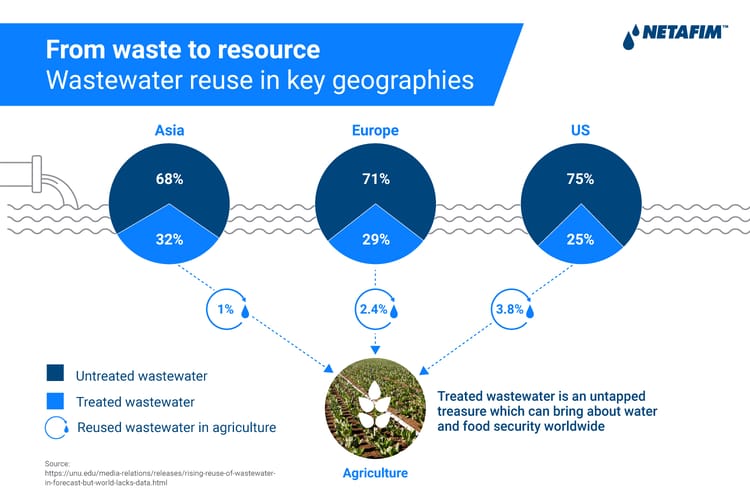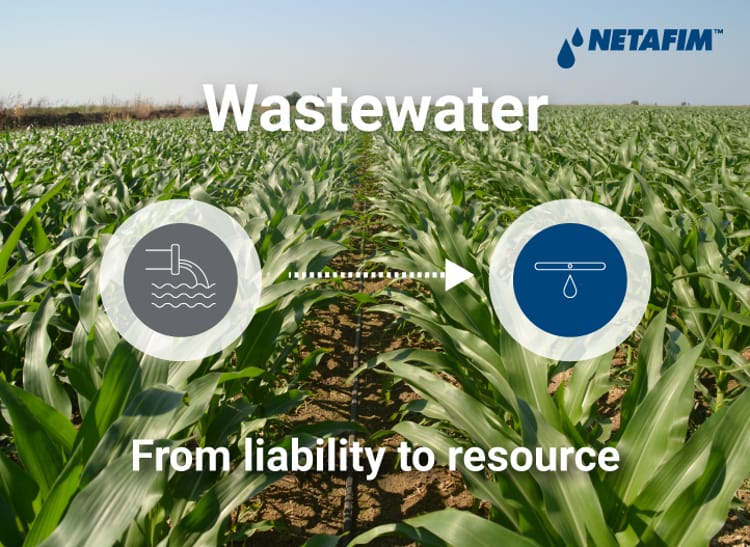We need to stop looking at wastewater as waste
When you think about wastewater what comes to mind (and nose)? Likely, a long list of bad-smelling, murky colored substances: human waste, sewage, food scraps, oils, soaps, and chemical pollutants. While no one argues that wastewater is a messy cocktail, a huge environmental hazard, and a painful headache for industry and municipalities, it also has unfulfilled potential as a valuable contributor to sustainable agriculture and a global food secure future. Given that half of the world's population will suffer severe water stress by 2030, the time has come to stop looking at wastewater as a liability and start maximizing its potential as a resource.
Wastewater - a treasure in disguise
Huge volumes of wastewater are generated daily in households, industry, and agriculture worldwide. The total volume of global wastewater discharge was recently estimated at 400 billion m3/year.
Wastewater usually consists of 99% water and 1% suspended, colloidal, and dissolved solids such as nutrients, pathogens, heavy metals, human feces, oils, runoff, and toxic chemicals. Although wastewater can not be used untreated, there are tremendous benefits to salvaging essential nutrients for reuse. Farmers are increasingly realizing the potential of treated wastewater for its high nutrient content and its ability to supplement water resources. If applied safely, wastewater is a valuable source of both water and nutrients, which can significantly contribute to water and food security worldwide.

Why can’t we dump wastewater on our fields?
Reusing wastewater as-is for crop irrigation is a really bad idea (and an illegal one in most parts of the world). If wastewater is not treated properly before being applied through irrigation, it can cause serious problems for the soil, crops, groundwater, and also the health of farmers and consumers.
In order to safely use wastewater, industrial discharges and municipal effluents need to be treated. Wastewater treatment is a process used to remove contaminants from wastewater or sewage and convert it into a solution that can be returned to the water cycle. There are numerous advantages to using treated wastewater. It improves the availability of water throughout the year and promotes the development of additional water sources for industry, municipalities, and above all, irrigation for agriculture and food production.
Why isn’t everyone doing it?
The process of reclaiming wastewater is underused globally due to the cost of treatment procedures, lack of regulation in many parts of the world and overall public concern. To date, irrigation with reclaimed wastewater represents only 1% of water used.
In North America, 75% of the total wastewater is treated, but only 3.8% of that treated wastewater is used. In Europe, only 2.4% of treated wastewater (700 Mm3 /year) is being reused. If the entire volume of treated wastewater in Europe were reused, it would supply 44% of agricultural irrigation needs, reducing 13% of withdrawals from natural sources.
In other parts of the world, some countries have started taking measures to ensure their water needs are met using treated wastewater. Israel is a good example of strategically investing in reusing treated wastewater for irrigation. A semi-arid country that historically suffers from water scarcity, Israel has taken steps towards achieving water security by revolutionizing its water recycling programs. Today, nearly 90% of Israel’s wastewater is recycled, around four times higher than any other country in the world. 45% of the water used in agriculture is treated effluent.

Drip irrigation to the rescue
Regulation has a critical role to play in the ability to reuse wastewater. In countries that use reclaimed water in agriculture such as Israel, Chile, and Mexico, the guidelines limit the use of reclaimed water through sprinkler, spray, flood, and furrow since there is a danger of exposing the crops to human pathogens. This is especially true with regards to food crops.
Drip irrigation speaks directly to the issues of safe wastewater effluent dispersal and offers four key advantages over conventional dispersal methods:
- It minimizes health risks associated with exposure to reclaimed water since drip applies water in a precise location and reduces the risk of having direct contact between the crop and the treated wastewater.
- It minimizes liability exposure associated with overspray and drifts from conventional sprinkler systems especially near residential properties.
- It eliminates leaching, thereby minimizing potential groundwater degradation and/or near seashore pollution.
- It eliminates runoff, ponding, and odor problems.
Wastewater contains high concentrations of dissolved solids which in some cases might create a risk of clogging or partial clogging of the drip system. The good news is that there’s a solution for this. There’s a wide range of filters that can protect drip irrigation systems effectively from heavily contaminated water. Such filters can capture all large particles that might affect the uniformity of irrigation and clean them out from the system effectively. In the race to find solutions for the usage of reclaimed water, Netafim, and the global irrigation industry have developed through the years highly efficient filters and varied technologies that can ensure that the wastewater that flows through the drip system will not clog it.
Getting creative with drip
Around the world, Netafim has been collaborating with farming communities to combine drip irrigation technologies with treated wastewater to respond to water scarcity.
In California, Netafim USA has pioneered an award winning 360 degree dairy wastewater solution to help dairies manage manure waste. The answer lies in utilizing advanced filtration and proprietary technology to blend dairy wastewater with fresh water, enabling the consistent and reliable application of dairy effluent as a nutrient-rich fertilizer. This process not only reuses water but also recycles manure as a natural crop nutrient and soil builder, reducing the need for commercial fertilizer.
Additionally, Netafim Italy developed a controlled system for the disposal of agricultural effluent from biogas facilities by injecting the treated wastewater into drip irrigation systems to use as fertilizer in an economic and sustainable way. This solution allows the disposal of wastewater in a controlled manner according to plant demand, to eliminate the negative effect and the dependence on mineral fertilizers. It also reduces the operation and cost of ground transportation related to the disposal and spreading of effluent on the field.
Wastewater - from liability to resource
The writing has been on the wall for quite a while now. If the world does not make significant water management changes, water demand is expected to surpass supply by 40% by 2030. What we do about it and how we handle it is totally in our hands. Given the need to safely and properly dispose of wastewater effluent and the growing and ongoing scarcity of water globally, the time has come to stop looking at wastewater as waste. What we need is a paradigm shift toward a circular economy in which wastewater is considered a valuable resource rather than a liability. Adopting practices which would safely and responsibly recycle wastewater will dramatically improve our mission to feed a growing world.

